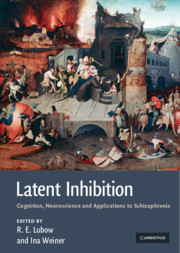Book contents
- Frontmatter
- Contents
- List of contributors
- Preface
- 1 A short history of latent inhibition research
- Current topics in latent inhibition research
- 2 Latent inhibition and extinction: their signature phenomena and the role of prediction error
- 3 Inter-stage context and time as determinants of latent inhibition
- 4 Latent inhibition: acquisition or performance deficit?
- 5 Latent inhibition and learned irrelevance in human contingency learning
- 6 Associative and nonassociative processes in latent inhibition: an elaboration of the Pearce–Hall model
- 7 From latent inhibition to retrospective revaluation: an attentional-associative model
- 8 Latent inhibition and habituation: evaluation of an associative analysis
- 9 Latent inhibition and creativity
- 10 The phylogenetic distribution of latent inhibition
- 11 The genetics of latent inhibition: studies of inbred and mutant mice
- 12 A comparison of mechanisms underlying the CS–US association and the CS–nothing association
- 13 The pharmacology of latent inhibition and its relevance to schizophrenia
- 14 Parahippocampal region–dopaminergic neuron relationships in latent inhibition
- 15 Latent inhibition and other salience modulation effects: same neural substrates?
- 16 What the brain teaches us about latent inhibition (LI): the neural substrates of the expression and prevention of LI
- 17 Latent inhibition in schizophrenia and schizotypy: a review of the empirical literature
- 18 A cautionary note about latent inhibition in schizophrenia: are we ignoring relevant information?
- 19 Latent inhibition as a function of anxiety and stress: implications for schizophrenia
- 20 Nicotinic modulation of attentional deficits in schizophrenia
- 21 Latent inhibition and schizophrenia: the ins and outs of context
- Summary and conclusions
- Index
- References
9 - Latent inhibition and creativity
from Current topics in latent inhibition research
Published online by Cambridge University Press: 04 August 2010
- Frontmatter
- Contents
- List of contributors
- Preface
- 1 A short history of latent inhibition research
- Current topics in latent inhibition research
- 2 Latent inhibition and extinction: their signature phenomena and the role of prediction error
- 3 Inter-stage context and time as determinants of latent inhibition
- 4 Latent inhibition: acquisition or performance deficit?
- 5 Latent inhibition and learned irrelevance in human contingency learning
- 6 Associative and nonassociative processes in latent inhibition: an elaboration of the Pearce–Hall model
- 7 From latent inhibition to retrospective revaluation: an attentional-associative model
- 8 Latent inhibition and habituation: evaluation of an associative analysis
- 9 Latent inhibition and creativity
- 10 The phylogenetic distribution of latent inhibition
- 11 The genetics of latent inhibition: studies of inbred and mutant mice
- 12 A comparison of mechanisms underlying the CS–US association and the CS–nothing association
- 13 The pharmacology of latent inhibition and its relevance to schizophrenia
- 14 Parahippocampal region–dopaminergic neuron relationships in latent inhibition
- 15 Latent inhibition and other salience modulation effects: same neural substrates?
- 16 What the brain teaches us about latent inhibition (LI): the neural substrates of the expression and prevention of LI
- 17 Latent inhibition in schizophrenia and schizotypy: a review of the empirical literature
- 18 A cautionary note about latent inhibition in schizophrenia: are we ignoring relevant information?
- 19 Latent inhibition as a function of anxiety and stress: implications for schizophrenia
- 20 Nicotinic modulation of attentional deficits in schizophrenia
- 21 Latent inhibition and schizophrenia: the ins and outs of context
- Summary and conclusions
- Index
- References
Summary
Latent inhibition (LI) is a robust phenomenon in which repeated preexposure to a stimulus that is not reinforced retards future associability to that stimulus (Lubow,1989). LI has been uniformly accepted as an adaptive mechanism across a variety of species (Lubow & Gewirtz, 1995). In humans, a deficit in LI has been associated with the active phase of schizophrenia and with psychosis-proneness (Baruch, Hemsley, & Gray, 1988a, 1988b; Lubow, Ingberg-Sachs, Zalstein-Orda, & Gewirtz, 1992). However, attenuated LI has also been reported in non-disordered normal subjects (see Braunstein-Bercovitz, Rammsayer, Gibbons, & Lubow, 2002), suggesting that attenuated LI exists on a continuum that extends from hospitalized psychotics to high-functioning normals. Recent research suggests that there may be situations in which attenuated LI actually confers an advantage to individuals. There is a growing body of evidence that indicates attenuated LI may be present in a subset of high-functioning and creative individuals (e.g. Carson, Peterson, & Higgins, 2003; Peterson & Carson, 2000). Attenuated LI may increase the probability of making novel or original associations among disparate stimuli by increasing the amount of information available to conscious awareness.
The theoretical relationship of creativity and latent inhibition
Latent inhibition is widely accepted as an index of the ability to ignore irrelevant stimuli (Lubow & Kaplan, 2005). When latent inhibition is expressed, the ability to form associations to information deemed irrelevant is reduced. Conversely, when latent inhibition is attenuated, the ability to form associations to seemingly irrelevant information is expanded.
- Type
- Chapter
- Information
- Latent InhibitionCognition, Neuroscience and Applications to Schizophrenia, pp. 183 - 198Publisher: Cambridge University PressPrint publication year: 2010
References
- 7
- Cited by



